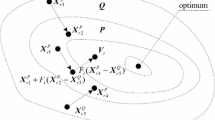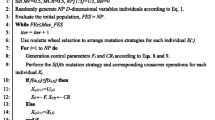Abstract
Differential evolution (DE) algorithm is widely used for solving real-parameter optimization problems due to its simplicity and efficiency. However the canonical DE is easy to suffer from the premature convergence. To further improve the performance of the DE, a differential evolution algorithm with dual preferred learning mutation (DPLDE) is proposed. Dual preferred learning mutation simultaneously learns behaviors from the individual with better fitness(BFI) and individual with better diversity(BDI). The learning factor of BFI is self-adaptively and independently adjusted for each individual. The learning factor of BDI is adaptively adjusted at each generation. A total of 26 Benchmark test functions with different characteristics are used for performance comparative experiments. The results show that DPLDE is superior to the eight state-of-the-art improved algorithms in terms of the convergence precision, convergence speed and stability. For the high-dimensional functions, with the same-scale population and maximum number of evolution generations, DPLDE can still get the excellent global optimization performance and has a more prominent advantage.







Similar content being viewed by others
References
Storn R, Price K (1995) Differential evolution: a simple and efficient adaptive scheme for global optimization over continuous spaces. University of California, Berkeley
Zheng JG, Wang X (2011) Diversity composite differential evolution algorithm for constrained optimization problems. Comput Integr Manuf Syst 17(11):2447–2456
Wang WL, Wang L, Wang HY et al (2012) Dynamic Job Shop scheduling based on hybrid differential evolution algorithm. Comput Integr Manuf Syst 18(3):531–539
Ghosh A, Datta A, Ghosh S (2013) Self-adaptive differential evolution for feature selection in hyperspectral image data. Appl Soft Comput 13(4):1969–1977
Nyirarugira C, Kim T (2013) Adaptive differential evolution algorithm for real time object tracking. IEEE Trans Consum Electron 59(4):833–838
Marcic T, Stumberger B, Stumberger G (2014) Differential evolution based parameter identification of a line-start IPM synchronous motor. IEEE Trans Indust Electron 61(11):5921–5929
Kadhar KMA, Baskar S, Amali SMJ (2015) Diversity controlled self-adaptive differential evolution based design of non-fragile multivariable PI controller. Eng Appl Artif Intell 46:209–222
Zhang J, Sanderson AC (2009) JADE: Adaptive differential evolution with optional external archive. IEEE Trans Evol Comput 13(5):945–958
Qin AK, Huang VL, Suganthan PN (2009) Differential evolution algorithm with strategy adaption for global numerical optimization. IEEE Trans Evol Comput 13:398–417
Wang Y, Cai Z, Zhang Q (2011) Differential evolution with composite trial vector generation strategies and control parameters. IEEE Trans Evol Comput 15(1):55–66
Mallipeddi R, Suganthan PN, Pan QK, Tasgetiren MF (2011) Differential evolution algorithm with ensemble of parameters and mutation strategies. Appl Soft Comput 11(2):1679–1696
Elsayed SM, Sarker RA, Essam DL (2014) A self-adaptive combined strategies algorithm for constrained optimization using differential evolution. Appl Math Comput 241:267–282
Gou J, Guo W -P, Hou F, Wang C, Cai Y -Q (2015) Adaptive differential evolution with directional strategy and cloud model. Appl Intell 42:369–388
Yi W, Gao L, Li X, Zhou Y (2015) A new differential evolution algorithm with a hybrid mutation operator and self-adapting control parameters for global optimization problems. Appl Intell 42:642–660
Tang L, Dong Y, Liu J (2015) Differential evolution with an individual-dependent mechanism. IEEE Trans Evol Comput 19(4):560–574
Guo S-M, Yang C-C, Hsu P-H, Tsai JS-H (2015) Improving differential evolution with a successful-parent-selecting framework. IEEE Trans Evol Comput 19(5):717–730
Wu G, Mallipeddi R, Suganthan PN, Wang R, Chen H (2016) Differential evolution with multi-population based ensemble of mutation strategies. Inf Sci 329:329–345
Yeh M-F, Lu H-C, Chen T-H, Leu M-S (2017) Modified Gaussian barebones differential evolution with hybrid crossover strategy. In: Proceedings of the 2016 international conference on machine learning and cybernetics, pp 7–12
Cai Y, Sun G, Wang T, Tian H, Chen Y, Wang J (2017) Neighborhood-adaptive differential evolution for global numerical optimization. Appl Soft Comput 59:659–706
Tang R (2017) Decentralizing and coevolving differential evolution for large-scale global optimization problems. Appl Intell 47:1208–1223
Wang S, Li Y, Yang H (2017) Self-adaptive differential evolution algorithm with improved mutation mode. Appl Intell 47:644–658
Nenavath H, Jatoth RK (2018) Hybridizing sine cosine algorithm with differential evolution for global optimization and object tracking. Appl Soft Comput 62:1019–1043
He X, Zhou Y (2018) Enhancing the performance of differential evolution with covariance matrix self-adaptation. Appl Soft Comput 64:227–243
Zhang X, Kang Q, Cheng J, Wang X (2018) A novel hybrid algorithm based on biogeography-based optimization and grey wolf optimizer. Appl Soft Comput 67:197–214
Cui L, Li G, Zhu Z, Lin Q, Wong K -C, Chen J, Lu N, Lu J (2018) Adaptive multiple-elites-guided composite differential evolution algorithm with a shift mechanism. Inf Sci 422:122–142
Wu G, Shen X, Li H, Chen H, Lin A, Suganthan PN (2018) Ensemble of differential evolution variants. Inf Sci 423:172– 186
Liu J, Lampinen J (2005) A fuzzy adaptive differential evolution algorithm. Soft Comput 9(6):448–462
Brest J, Greiner S, Boskovic B, Mernik M, Zumer V (2006) Self-adapting control parameters in differential evolution: a comparative study on numerical Benchmark problems. IEEE Trans Evol Comput 10 (6):646–657
Nasimul N, Danushka B, Hitoshi I (2011) An adaptive differential evolution algorithm. In: IEEE congress on evolutionary computation. IEEE Press, New Orleans, pp 2229–2236
Gong W, Cai Z (2013) Differential evolution with ranking-based mutation operators. IEEE Trans Cybern 43(6):2066–2081
Zhu W, Tang Y, Fang J -A, Zhang W (2013) Adaptive population tuning scheme for differential evolution. Inf Sci 223:164–191
Tanabe R, Fukunaga A (2013) Success-history based parameter adaptation for differential evolution. In: IEEE congress on evolutionary computation, pp 71–78
Wenyin G, Zhihua C, Yang W (2014) Repairing the crossover rate in adaptive differential evolution. Appl Soft Comput 15:149–168
Fan Q, Yan X (2015) Self-adaptive differential evolution algorithm with discrete mutation control parameters. Expert Syst Appl 42: 1551–1572
Wang Y, Cai Z, Zhang Q (2012) Enhancing the search ability of differential evolution through orthogonal crossover. Inf Sci 185:153–177
Xie Y, Zhao C-X, Zhang H-F, Yan X-J, Chen D-B (2015) A blending crossover differential evolution approach to camera space manipulation parameter optimization. Acta Phys Sin 2:1–7
Cai Y, Wang J (2015) Differential evolution with hybrid linkage crossover. Inf Sci 320:244–287
Guo S -M, Yang C -C (2015) Enhancing differential evolution utilizing eigenvector-based crossover operator. IEEE Trans Evol Comput 19(1):31–49
Xu Y, Fang J-A, Zhu W, Wang X, Zhao L (2015) Differential evolution using a superior-inferior crossover scheme. Comput Optim Appl 61:243–274
Ghosh A, Das S, Mullick SS, Mallipeddi R, Das AK (2017) A switched parameter differential evolution with optional blending crossover for scalable numerical optimization. Appl Soft Comput 57:329–352
Cheng R, Jin Y (2015) A social learning particle swarm optimization algorithm for scalable optimization. Inf Sci 291:43–60
Price K, Storn R, Lampinen J (2005) Differential evolution: a practical approach to global optimization. Springer, Berlin
Storn R, Price K (2010) Home page of differential evolution. Int Comput Sci Inst, Berkeley, CA, USA
Montgomery J, Chen S (2010) An analysis of the operation of differential evolution at high and low crossover rates. In: 2010 IEEE congress on evolutionary computation, (CEC), pp 1–8
Liang JJ, Qu BY, Suganthan PN, Chen Q (2015) Problem definition and evaluation criteria for the CEC 2015 competition on learning-based real-parameter single objective optimization
Suganthan PN, Hansen N, Liang JJ, Deb K, Chen Y-P, Auger A, Tiwari S (2005) Problem definitions and evaluation criteria for the CEC 2005 special session on real-parameter optimization, pp 1–50
Funding
This work is supported by the National 863 Project (NO. 2015AA016405).
Author information
Authors and Affiliations
Corresponding author
Rights and permissions
About this article
Cite this article
Duan, M., Yang, H., Liu, H. et al. A differential evolution algorithm with dual preferred learning mutation. Appl Intell 49, 605–627 (2019). https://doi.org/10.1007/s10489-018-1267-2
Published:
Issue Date:
DOI: https://doi.org/10.1007/s10489-018-1267-2




